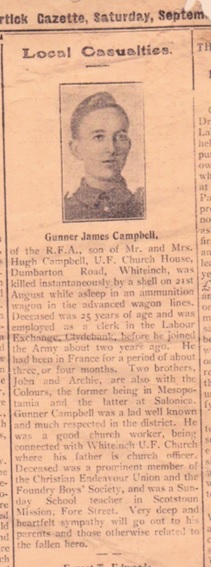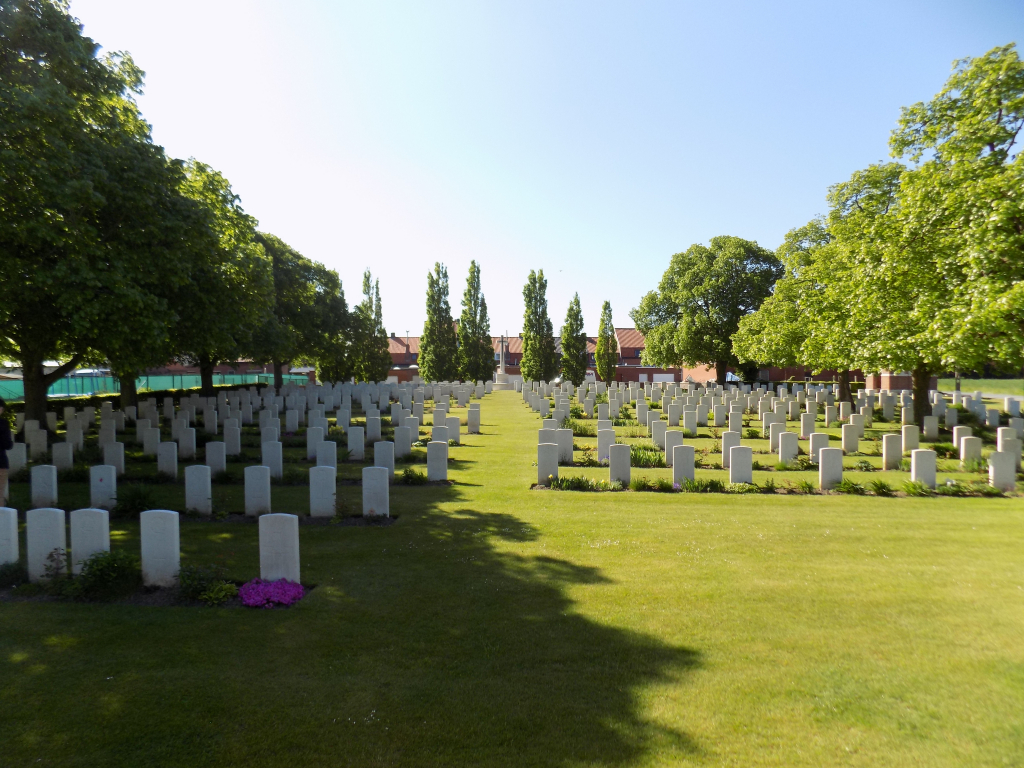- See James Campbell’s entry on the Board of Trade’s Ancestry public tree.
- This information updates the group’s previous research published on the former DTI website (now archived by the National Archives).
- Do you have any more information about James Campbell? If so the War Memorial Research Group would love to hear from you
Name recorded on Board of Trade Memorial: J. Campbell
Born: Anderston, Lanark, Scotland
Date of Death: 20 August 1917
Age at death: 25
Service, Regiment, Corps, etc: Royal Field Artillery
Unit, Ship, etc: 32nd Battery
Enlisted: Glasgow
Rank: Gunner (Service No: 660680)
Decorations: WW1 Service Medals (Victory Medal and British War Medal)
War (and theatre): WW1 (France and Flanders)
Manner of Death: Killed in Action
Family Details: Son of Hugh and Flora Campbell of Glasgow
Residence: Glasgow
Home Department: Board of Trade – Labour Department (Scotland Division)
Civilian Rank: Clerk at Labour Exchange, Clydebank
Cemetery or Memorial: Belgian Battery Corner Cemetery, Ypres (I.J.4); Board of Trade War Memorial; Memorial to the Staff of the Ministry of Labour, Caxton House, Tothill Street, London
Biography:

James Campbell was born on 21 March 1892 in Anderston, Lanark, Scotland. His parents were Hugh Campbell (1856-1933) and Flora Anne Sinclair (1858-1936). His father was an engineer. He had two brothers – John Campbell (1889-?) and Archibald Sinclair Campbell (1894-1965) who also fought during WW1. John served in Mesopatamia and Archibald served in Salonica.
In the 1901 census the family are living at 45 Roseval Street, Partick, Glasgow. Later, the Campbell family home was the United Free Church House on Dumbarton Road, Whiteinch, Glasgow.
We know that James attended Govan Hill Public School. Whilst a pupil at the school, James was awarded a prize for general excellence on 29 April 1898.
After leaving school, he worked for the Board of Trade as a Clerk at the Labour Exchange in Clydebank.

He was also an active church goer and took his first communion at the Whiteinch United Free Church on 16 March 1913. He was also a prominent member of the Christian Endeavour Union and the Foundry Boys’ Society and was a Sunday School teacher at Scotstoun Mission.
We know that James enlisted to serve in WW1 on 1 June 1915. His relatives still have records and mementos and letters of his time serving in WW1. Like many young men serving in the army these speak of his daily activities and life in the army. He also speaks of those who have died and talks about the shooting of a Zeppelin and he also wishes to be reunited with his brothers.
He served as a Gunner in the 32nd Battery of the Royal Field Artillery Company and served in France for about three or four months. The RFA was the largest branch of artillery and provided close artillery support for the infantry. It was responsible for manoeuvrable medium calibre guns and howitzers used close to the front lines.
James died on 21 August 1917 aged 25. According to the newspaper report detailing his death, he was “killed instantaneously by a shell on 21st August while asleep in an ammunition wagon in the advanced wagon lines”.
His obituary in the Partick Gazette remembers that “Gunner Campbell was a lad well known in the district. He was a good church worked, being connected with Whiteinch U.F. Church where his father was a church officer”. James was one of 240 young men from Whiteinch United Free Church who served in the military during WW1 (and one of 40 men from the congregation who died).

At a service held in honour of his life on 2 September 1917, the Reverend Thomas Tully gave a sermon in recognition of his life. He recalled that “he was temperamentally a son of light and what he was temperamentally was enlarged and enriched by the love of Christ”. He continued that “some of us remember how eager he was to do his bit for his country in the great struggle for freedom and righteousness — He too at first had difficulty in being accepted, but at once he set to work to remove the obstacle, and by sedulous exercises he got up the necessary measurements. That is the spirit that counts. And now it is all over. He has made the supreme sacrifice”.
James is buried in the Belgian Battery Corner Cemetery near about 2km south-west of Ypres. His grave is one of 573 WW1 servicement who are either buried or commemorated at the cemetery (7 of whom are unidentified). The cemetery was started in June 1917 after the Battle of Messines and used until October 1918.
He is also remembered on two Civil Service War Memorials – the Board of Trade War Memorial and the Memorial to the Staff of the Ministry of Labour both.

In keeping with his religious faith, which he maintained throughout his life, James’ gravestone inscription bears the Gaelic words: “IS BEANNAICHTE NA DAOINE A THA GLAN ‘N AN CRIDHE OIR CHI IAD DIA”. This translates as “Blessed are the pure in heart for they shall see God”.
